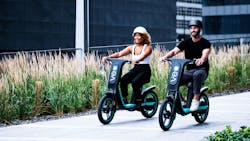OP-ED: We have the funds – now let’s get real about ending car dependency
The pandemic spurred communities across the nation to reimagine how to use public space for people instead of cars. Two years in, many cities are making slow streets, quick build bike lanes and outdoor dining hubs permanent, realizing that these spaces are not only good for the planet but also expand access to economic opportunity and foster happier, more connected neighborhoods. Meanwhile, e-bike sales are booming and use of shared scooters and bikes is on the rise.
So why are Americans going to such extreme lengths to buy cars? It’s not that Americans want to take on the financial burden of car ownership. But too often, they lack better options.
The $1.2 trillion infrastructure bill that President Joe Biden signed into law in November 2021 can give Americans the options they need to get around without a car. But it will be up to the leadership in our states and cities to follow U.S. Department of Transportation guidance and focus investments toward transit and complete streets and away from costly highway expansion projects that worsen sprawl and car dependency. How this funding is spent will determine whether the infrastructure bill will help us act on climate or thwart our emissions reduction goals. With transportation emissions on the rise, we have to act fast.
As a micromobility founder, I talk to city leaders on a regular basis about how to ensure scooters and bikes are a safe option for residents to make daily trips and transit connections. Time and time again, it comes down to three key components: safe vehicles, safe riding behavior and safe streets. It’s up to micromobility companies to engineer e-bikes and e-scooters that are safe to use and to educate our riders about how to travel safely. But we need to collaborate on safer streets. Fortunately, infrastructure funds create new possibilities for what we can do together.
What should we spend infrastructure funds on? Imagine a future where robust transit and shared mobility – paired with protected bike lanes and complete streets – make car ownership obsolete. The infrastructure bill provides state and local transportation departments with expanded capacity to fund this future. It also explicitly makes micromobility eligible for funding under existing large funding programs like the Congestion Mitigation and Air Quality Improvement Program. These funds can be used for everything from installing designated micromobility parking on city streets, to mobility hubs, to education and outreach programs that inform communities about their transportation options.
However, the federal transportation program is often deferential to states and localities on the specifics of how these funds are used – which leaves the potential for money to be spent on projects that reverse the progress we’ve made on climate and safe streets. For the infrastructure bill to have a real impact on climate and safety, states and cities must prioritize projects for sustainable and active transportation, all while ensuring that the benefits go to the communities that need them most. Many low-income communities and communities of color have been shut out of urban planning processes in the past, forcing them to bear unequal burdens of car dependency and air pollution. Careful allocation of infrastructure funds – paired with collaboration with communities on how to spend these funds – can support equitable pathways to a sustainable future.
And we must keep up the momentum. Measures like the Build Back Better Act that include tax credits for e-bikes, additional investments in transit and funding for equity and climate-focused programs are essential if we want to get serious about ending car dependency.
But we don’t need to wait for more funding to transform our streets. Washington has already delivered significant resources to get started. Now, we need state and local officials to show leadership and execute at the block-by-block level.
And, of course, micromobility companies need to do our part. That means continuing to share travel data with our city partners so they can make more informed decisions about where to locate a new mobility hub or pilot the next quick-build bike lane. We should also support cities’ community engagement efforts by leveraging our platforms – which give us the ability to reach thousands of riders at the touch of a button – to send notifications when our partner cities are seeking feedback on safe streets proposals.
Emergency authorization for protected bike lanes and slow streets has allowed cities to move faster than ever before. Cities have data that shows there is demand for sustainable, people-centric infrastructure. And crucially, they have the funds. Now is the time for our state and local officials to get serious about ending car dependency and providing clean mobility for all. Let’s put our heads together and get it right.
Candice Xie is the Co-founder and CEO of Veo.
About the Author

Candice Xie
Co-founder and CEO, Veo
Candice Xie is the Co-founder and CEO of Veo. Under Candice’s leadership, Veo deliberately and selectively grew its market presence in the U.S. and became the first profitable micromobility company in the industry.
